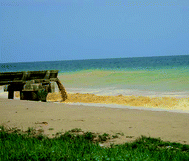The state of contamination of tropical environments, particularly in Africa, remains a relatively under explored subject. Here, we determined polycyclic aromatic hydrocarbon (PAH) and trace metal concentrations in coastal sediment and biota samples (fish and mussels) from Togo (West Africa). In the sediments, the ∑21 PAH concentrations ranged from <4 ng g−1 to 257 ng g−1, averaging 92 ng g−1. Concentration ratios of low molecular weight PAHs (2–3 rings) versus high molecular weight PAHs (≥4 rings) were always lower than 1 (ranging from 0.08 to 0.46) indicating that high molecular weight PAHs were dominant in all sediment samples, and that PAHs originated mainly from anthropogenic combustion activities. The sediments were also analyzed for major elements and a total of 15 trace metals, which were found in elevated concentrations. The calculated enrichment factor (EF) values relative to the Earth’s crust show that the contamination is extremely severe for Cd (EF = 191), severe for Cr (EF = 18) and U (EF = 17.8), moderately severe for Zr (EF = 8.8), for Ni (EF = 6.8), Sr (EF = 5.9) and Ba (EF = 5.4), and moderate for V (EF = 3.6) and Zn (EF = 3.4). Sediments sampled in areas affected by the dumping of phosphorite mine tailings showed particularly high concentrations of trace metals. Overall, concentrations of both PAHs and trace metals in sediment tend to increase from the coastline to the open sea (2 km offshore). This is attributable to the increasingly finer texture of coastal sediment found offshore, which has a terrigenous origin and appears loaded with various contaminants through adsorption processes. Such high loads of trace metals were also found in the biota (fish and mussels). The ratio of measured trace metal concentrations in biota to threshold limits set by the World Health Organization herein defined as relative health factor (RHF) was high. Average RHF values in fish were highest for Se (470), As (250), Ag (97), Ni (78), Mn (63), Fe (53), Pb (36), Cd (10), and Cr (7) while lowest for Cu (0.08) and Zn (0.03). Cd and Al did not bioaccumulate in the analyzed fish species. In mussels, the RHF values were highest for Fe (9,108), As (295), Pb (276), Se (273), Mn (186), Ni (71), Ag (70), Cd (14), and Cu (4).


 Please wait while we load your content...
Please wait while we load your content...